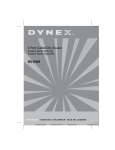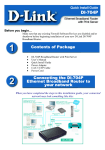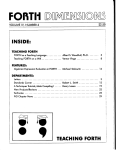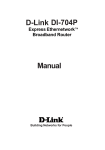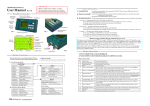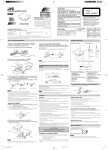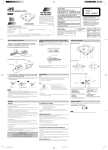Download D-Link DI 704 - Gateway Specifications
Transcript
D-Link DI-704P TM Express Ethernetwork Broadband Router with Print Server Manual Building Networks for People Contents Package Contents ................................................................................3 Introduction............................................................................................4 Features and Benefits ...........................................................................5 LEDs ....................................................................................................6 Connections ..........................................................................................7 Introduction to Broadband Technology ...................................................8 Sample Scenario ................................................................................10 Network Setup .................................................................................... 11 Setup Wizard ......................................................................................12 Using the Configuration Menu..............................................................17 Networking Basics ..............................................................................62 Reset ..................................................................................................90 Technical Specifications ......................................................................91 Contacting Technical Support ..............................................................92 Warranty ..............................................................................................93 Registration ........................................................................................96 2 Package Contents Contents of Package: D-Link DI-704P Express EtherNetworkTM Broadband Router Manual, Warranty and Print Server Software on CD Quick Installation Guide Power Adapter - 5V DC Ethernet (CAT5-UTP/Straight-Through) Cable If any of the above items are missing, please contact your reseller. WARNING! Using a power supply with a different voltage rating than the one included with the DI-704P will cause damage and void the warranty for this product. System Requirements for Configuration: Ethernet-based Cable or DSL Modem Computer with Windows, Macintosh, or Linux-based Operating System with an installed Ethernet adapter Internet Explorer version 6.x or Netscape Navigator version 6.x and above, with Javascript enabled 3 Introduction Thank you for purchasing DI-704P 4-Port Ethernet Broadband Router. The DI704P is an Ethernet Broadband Router with a built-in 4-port switch. It also features a parallel port to share a printer on the home or office network and includes a print server application for Windows1. As many as four computers can be connected directly to the router’s integrated switch, using its four 10/100Mbps AutoMDIX Ethernet ports. More computers can be added to the network by connecting additional switches to the DI-704P. The DI-704P package even includes an Ethernet cable to get you started. The DI-704P is ideal if you’re creating your first home or small business network, or if you’re a more advanced user looking for additional management settings. The DI-704P includes a new, easy-to-use D-Link web-based graphical user interface (GUI) to configure the router. To prevent unwanted Internet intruders from accessing your private network, the DI-704P also serves as a feature-rich firewall. So, whether you’re a college student who wants to network with friends and roomates, an executive working at home or in a small office, or a concerned parent who just wants to have more control over how your children access the Internet, then the D-Link Express EtherNetwork DI-704P is the networking solution for you. 1 Print Server software included is for Windows Operating Systems only. Postscript Level 1 and 2 printers can be connected to the DI-704P for Macintosh OS 9.x or X computers. The DI-704P does not support non-Postscript printers with Macintosh OS. 4 Features & Benefits Firewall Features Filtering - Easily applied filtering based on Media Access Control (MAC) Addresses, IP Addresses, Port Addresses, and time schedule allows or denies computer on the network access to the Internet. Network Address Translation - NAT allows your private network to share a single public IP address. All your computer connected to the DI-704P will be on a private network shielded from Internet intruders. Built-In 4-Port Switch - Allows you to quickly and easily share an Internet connection with multiple computers and devices. Each 10/ 100 Ethernet Port automatically senses and accepts the type of Category (CAT) 5 cable you attach - whether straight through or cross-over. Connect additional switches to allow more computer to access the Internet. Built-In Print Server - Includes a parallel port to connect to a centronic printer and includes a Windows-based print server software application, so users on the network can share the printer1. The print server is also capable of TCP/IP printing. Ethernet Cable Included - One Ethernet cable is included with the DI-704P to get you started. Simple Setup Wizard for Easy Installation - The D-Link setup wizard simplifies the installation process, getting you up and running in just a few clicks. 1 Print Server software included is for Windows Operating Systems only. Postscript Level 1 and 2 printers can be connected to the DI-704P for Macintosh OS 9.x or X computers. The DI-704P does not support non-Postscript printers with Macintosh OS. 5 LEDs M1 LED POWER LED LED M2 LED WAN LED LOCAL NETWORK LEDs LED Activity Power A solid light indicates a proper connection to the power supply. M1 LED Flashes consistently to indicate that the DI-704P is working properly. M2 LED Solid light indicates that Internet connection has been established. WAN A Solid light indicates connection on the WAN port. This LED blinks during data transmission. LOCAL NETWORK LEDs (Ports 1-4) A solid light indicates a connection to an Ethernet-enabled computer on ports 1-4. This LED blinks during data transmission 6 Connections Printer Port WAN Port LAN Ports Reset Button Receptor for Power Adapter Receptor for Power Adapter Connect the supplied power adapter that came with the unit. Using the wrong power adapter will damage the unit. Reset Button Reset button is to reset the device to its factory default settings. Printer Port Connect to the printer using a parallel cable. This feature is used to share the printer on the network. WAN Port WAN port is the connection point for your DSL or Cable modem. Lan Ports LAN port is where you would connect each computer to your network. WARNING! Using a power supply with a different voltage rating than the one included with the DI-704P will cause damage and void the warranty for this product. 7 Introduction to Broadband Router Technology A router is a device that forwards data packets from a source to a destination. Routers can work on Open System Interconnection (OSI) layer 3, which forwards data packets using an IP address and not a MAC address. A router will forward data from the Internet to a particular computer on your LAN. The information that makes up the Internet gets moved around using routers. When you click on a link on a wed page, you send a request to a server to show you the next page. The information that is sent and received from your computer is moved from your computer to the server using routers. A router also determines the best route that your information should follow to ensure that the information is delivered properly. A router controls the amount of data that is sent through your network by eliminating information that shouldn’t be there. This provides security for the computers behind your router because computers from the outside cannot access or send information directly to any computer on your network. The router determines which computer the information should be forwarded to and sends it. If the information is not intended for any computer on your network, the data is discarded. This keeps any unwanted or harmful information from accessing or damaging your network. Introduction to Firewalls A firewall is a device that sits between your computer and the Internet that prevents unauthorized access to or from your network. A firewall can be a computer using firewall software or a special piece of hardware built specifically to act as a firewall. In most circumstances, a firewall is used to prevent unauthorized Internet users from accessing private networks suchs as corporate LANs and Intranets. A firewall watches all of the information moving to and from your network and analyzes each piece of data. Each piece of data is checked against a set of criteria that the administrator configures. If any data does not meet the criteria, that data is blocked and discarded. If the data meets the criteria, the data is paased through.. This method is called packet filtering. A firewall can also run specific security functions based on the type of application or type of port that is being used. For example, a firewall can be configured to work with an FTP or Telnet server. Or a firewall can be configured to work with specific UDP or TCP ports to allow certain applications or games to work properly over the Internet. 8 Introduction to Local Area Networking Local Area Networking (LAN) is the term used when connecting several computers together over a small area such as a building or group of buildings. LAN’s can be connected over large areas. A collection of LANs connected over a large area is called a Wide Area Network (WAN). A LAN is consists of multiple computers connected to each other. There are many types of media that can connect computers together. The most common media is CAT5 cable; UTP or STP twisted pair wire. Each computer must have a Network Interface Card (NIC), which communicates the data between computers. A NIC is usually a 10Mbps network card or 10/100Mbps network cards. Most networks use hardware devices such as hubs or switches that each cable can be connected to in order to continue the connection between computers. A hub simply takes any data arriving through each port and forwards the data to all other ports. A switch is more sophisticated, in that a switch can determine the port that each piece of data is supposed to be delivered to. A switch minimizes network traffic and speeds up the communication over a network. Networks take some time in order to plan and implement correctly. There are many types of scenarios to consider which could affect the operability of a network. Some of these issues are discussed in the manual under the Networking Basics section. 9 Sample Scenario 1 2 5 4 3 6 A typical network setup at home (as shown above) might contain the following devices. For specific information on setting up your network with the DI-704P please see the Network Setup section on the following page. You will need broadband Internet access (a Cable or DSL subscription line into your home or office) Consult with your Cable or DSL provider for proper installation of the modem Connect the Cable or DSL modem to the DI-704P wireless broadband router (see the Quick Installation Guide included with the DI-704P.) If you are connecting a desktop computer to your network, you can install the D-Link DFE-530TX+ Ethernet adapter into an available PCI slot. (See the Quick Installation Guide included with the DWL-530TX+.) If you are connecting a laptop computer to your network, install the drivers for the Ethernet Cardbus adapter (e.g., D-Link DFE-690TXD) into a laptop computer.(See the Quick Installation Guide included with the DFE-690TXD.) Connect your printer to the printer port on the DI-704P. Please refer to the quick installation guide for loading the print server software. ** Easily upgrade to a wireless network by adding a wireless Access Point (D-Link DWL-900AP+) ** 10 Network Setup Turn everything off. A. Power OFF your Cable or DSL modem. If you modem does not have an on/off switch, disconnect the power cable. B. Turn OFF your computer. C. Do NOT connect the power adapter to your D-Link router. Connect the D-Link Router Cables. A. Connect the Ethernet (or networking) cable from the Cable or DSL modem to the WAN port of the router. B. Use the D-Link supplied Ethernet cable to connect the Ethernet port (Network Card) of your computer to one of the LAN ports of the router. The complete setup should look like Fig.1 shown above. Power up the devices in sequence. A. Power up the Cable or DSL modem. Wait until the modem has made the connection to your Internet Service Prover’s (ISP’s) network. Note: Please see the Manual included with your modem for an explanation of the modem’s LEDs. B. Power up the D-Link router by connecting the D-Link provided power adapter to the router and to an available power outlet. C. Turn on your computer. D. Now, refer to either the Quick Installation Guide or continue to follow this manual to complete the installation process. 11 Using the Setup Wizard Open your Web browser and type “http://192.168.0.1” into the URL address box. Then press the Enter or Return key. The logon pop-up screen will appear. Type “admin” for the username and leave the password field blank. Click OK Once you have logged in, the Home screen will appear. Click Run Wizard 12 Using the Setup Wizard (continued) You will see the following screens Click Next Set up your new password. You have the option to establish a password. Click Next 13 Using the Setup Wizard (continued) Set up your Time Zone. You have the option to the set standard time for your router. To change the default selection, select the drop down arrow and chose the correct time zone. Click Next Select your Internet Connection. You will be prompted to select the type of Internet connection for your router. If you are unsure of which setting to select, please contact your Internet Service Provider. Click Next Select Others only if you use PPTP in Europe or BigPond Cable in Australia. 14 Using the Setup Wizard (continued) If you selected Dynamic IP Address, this screen will appear: (Used mainly for Cable Internet service.) Click the “Clone MAC Address” button to automatically copy the MAC address of the network adapter in your computer. You can also manually type in the MAC address. What is a MAC address? Each network adapter has a discrete Media Access Control (MAC) address. Note that some computers and peripherals may already include built-in network adapters. Click Next If your ISP requires a Static IP Address, and this option is selected, then this screen will appear: Enter the IP Address information originally provided to you by your ISP. You will need to complete all the required fields. Click Next 15 Using the Setup Wizard (continued) If your ISP uses PPPoE (Point-to-Point Protocol over Ethernet), and this option is selected, then this screen will appear: (Used mainly for DSL Internet service.) Please be sure to remove any existing PPPoE client software installed on your computers. Enter in the username and password provided to you by your ISP. Click Next Click Restart 16 Using the Configuration Menu Whenever you want to configure your network or the DI-704P, you can access the Configuration Menu by opening the web-browser and typing in the IP Address of the DI704P. The DI-704P default IP Address is shown below: Open the web browser Type in the IP Address of the DI-704P Home > Wizard Note: if you have changed the default IP Address assigned to the DI-704P, make sure to enter the correct IP Address. The factory default User name is “admin” and the default Password is blank (empty). It is recommended that you change the admin password for security purposes. Please refer to Tools>Admin to change the admin password. 17 Using the Configuration Menu (continued) Home > Wizard (continued) The Home>Wizard screen will appear. Please refer to the Quick Installation Guide for more information regarding the Setup Wizard. Clicking Apply will save changes made to the page Clicking Cancel will clear changes made to the page Clicking Help will bring up helpful information regarding the page Clicking Restart will restart the router. (Necessary for some changes.) 18 Using the Configuration Menu (continued) Home > WAN (continued) WAN is short for Wide Area Network. The WAN settings can be referred to as the Public settings. All IP information in the WAN settings are public IP addresses which are accessible on the Internet. The WAN settings consist of four options: Dynamic IP Address, Static IP Address, PPPoE, and Others. Select the appropriate option and fill in the information needed to connect to your ISP. Choose Dynamic IP Address to obtain IP address information automatically from your ISP. Select this option if your ISP does not give you any IP numbers to use. This option is commonly used for Cable modem services. Host Name: The Host Name field is optional but may be required by some ISPs. The host name is the device name of the Broadband Router. 19 Using the Configuration Menu (continued) Home > WAN (continued) MAC Address: The default MAC address is set to the WAN’s physical interface MAC address on the Broadband Router. You can use the “Clone MAC Address” button to copy the MAC address of the Ethernet Card installed by your ISP and replace the WAN MAC address with this MAC address. It is not recommended that you change the default MAC address unless required by your ISP. Primary/Secondary DNS Address: Enter a DNS Address if you do not wish to use the one provided by your ISP. MTU: Only enter the MTU if it is required by your ISP. Otherwise, leave it at the default setting of 1500. Auto-reconnect: If enabled, the Broadband Router will automatically connect to your ISP after your system is restarted or if the connection is dropped. 20 Using the Configuration Menu (continued) Home > WAN > Static IP Address Choose Static IP Address if all WAN IP information is provided to you by your ISP. You will need to enter in the IP Address, subnet mask, gateway address, and DNS address(es) provided to you by your ISP. Each IP address entered in the fields must be in the appropriate IP form, which are four IP octets separated by a dot (x.x.x.x). The Router will not accept the IP Address if it is not in this format. IP Address: Public IP address provided by your ISP. Subnet Mask: Subnet mask provided by your ISP. ISP Gateway Address: Public IP address of your ISP that you are connecting to. Primary/Secondary DNS Address: Enter a DNS Address if you do not wish to use the one provided by your ISP. MTU: Enter an MTU value only if required by your ISP. Otherwise, leave it at the default setting of 1500. 21 Using the Configuration Menu (continued) Home > WAN > PPPoE Please be sure to remove any Client Software program on your computer before you start your configuration of the DI-704P Router. Choose PPPoE (Point to Point Protocol over Ethernet) if your ISP uses PPPoE connection. Your ISP will provide you with a username and password. This option is typically used for DSL services. Select Dynamic PPPoE to obtain an IP address automatically for your PPPoE connection. Select Static PPPoE to use a static IP address for your PPPoE connection. 22 Using the Configuration Menu (continued) Home > WAN > PPPoE (continued) Dynamic PPPoE: PPPoE connection where you will receive an IP address automatically from your ISP Static PPPoE: PPPoE connection where you have an assigned (static) IP address User Name: Your PPPoE username provided by your ISP Password: Your PPPoE password provided by your ISP Retype Password: Re-enter PPPoE password Service Name: Enter the service name provided by your ISP. (optional) IP Address: This option is only available for Static PPPoE. Enter in the static IP address for the PPPoE connection. Primary DNS Address: Primary DNS IP provided by your ISP Secondary DNS Address: Optional Maximum Idle time: The amount of time of inactivity before disconnecting your PPPoE session. Enter a Maximum Idle Time (in minutes) to define a maximum period of time for which the Internet connection is maintained during inactivity. If the connection is inactive for longer than the defined Maximum Idle Time, then the connection will be dropped. Either set this to zero or enable Auto-reconnect to disable this feature. MTU: MTU stands for Maximum Transmission Unit. For PPPoE connections, you may need to change the MTU settings in order to work correctly with your ISP. Auto-reconnect: If enabled, the Broadband Router will automatically connect to your ISP after your 23 system is restarted or if the connection is dropped. Using the Configuration Menu (continued) Home > WAN > PPTP Dynamic IP Address for PPTP is a WAN connection used in Europe. My IP Address: Enter in the IP address for the My Subnet Mask: Enter the subnet mask information. Server IP: Enter the Server IP address. By default, its set to 192.168.0.1 24 Using the Configuration Menu (continued) Home > WAN > PPTP (continued) PPTP Account: Enter in the username for the PPTP account PPTP Password: Enter the password for the PPTP account. Retype in Password to confirm Connection ID: (Optional) enter the Connection ID if required Maximum Idle Time: The amount of time of inactivity before disconnecting your PPPoE session. Enter a Maximum Idle Time (in minutes) to define a maximum period of time for which the Internet connection is maintained during inactivity. If the connection is inactive for longer than the defined Maximum Idle Time, then the connection will be dropped. Either set this to zero or enable Auto-reconnect to disable this feature. Auto-reconnect: If enabled, the device will automatically connect to your ISP after your unit is restarted or when the connection is dropped. 25 Using the Configuration Menu (continued) Home > WAN > BigPond Cable Dynamic IP Address for BigPond is a WAN connection used in Australia. Account: Enter in the username for the BigPond account Password: Enter the password for the BigPond account Login Server: (Optional) enter the Login Server name if required Auto-reconnect: If enabled, the device will automatically connect to your ISP after your unit is restarted or when the connection is dropped. 26 Using the Configuration Menu (continued) Home > LAN LAN is short for Local Area Network. This is considered your internal network. These are the IP settings of the LAN interface for the DI-704P. These settings may be referred to as Private settings. You may change the LAN IP address if needed. The LAN IP address is private to your internal network and cannot be seen on the Internet. IP Address: The IP address of the LAN interface. The default IP address is 192.168.0.1. Subnet Mask: The subnet mask of the LAN interface. The default subnet mask is 255.255.255.0. Local Domain Name: This field is optional. Enter in the your local domain name. 27 Using the Configuration Menu (continued) Home > DHCP DHCP stands for Dynamic Host Control Protocol. The DI-704P has a built-in DHCP server. The DHCP Server will automatically assign an IP address to the computers on the LAN/private network. Be sure to set your computers to be DHCP clients by setting their TCP/IP settings to “Obtain an IP Address Automatically.” When you turn your computers on, they will automatically load the proper TCP/IP settings provided by the DI-704P. The DHCP Server will automatically allocate an unused IP address from the IP address pool to the requesting computer. You must specify the starting and ending address of the IP address pool. 28 Using the Configuration Menu (continued) Home > DHCP Static DHCP allows computers on the LAN to receive the same DHCP IP address everytime it boots up. You can bind a specific IP address to a specific computer based on the computer’s MAC address Starting IP address: The starting IP address for the DHCP server’s IP assignment. Ending IP address: The ending IP address for the DHCP server’s IP assignment. Lease Time: The length of time for the IP lease. 29 Using the Configuration Menu (continued) Advanced > Virtual Server The DI-704P can be configured as a virtual server so that remote users accessing Web or FTP services via the public IP address can be automatically redirected to local servers in the LAN (Local Area Network). The DI-704P firewall feature filters out unrecognized packets to protect your LAN network so all computers networked with the DI-704P are invisible to the outside world. If you wish, you can make some of the LAN computers accessible from the Internet by enabling Virtual Server. Depending on the requested service, the DI-704P edirects the external service request to the appropriate server within the LAN network. 30 Using the Configuration Menu (continued) Advanced > Virtual Server The DI-704P is also capable of port-redirection meaning incoming traffic to a particular port may be redirected to a different port on the server computer. Each virtual services that are created will be listed at the bottom of the screen in the Virtual Servers List. There are already pre-defined virtual services already in the table. You may use them by enabling them and assigning the server IP to use that particular virtual service. Name: The name referencing the virtual service. Private IP: The server computer in the LAN (Local Area Network) that will be providing the virtual services. Private Port: The port number of the service used by the Private IP computer. Protocol Type: The protocol used for the virtual service. Public Port: The port number on the WAN side that will be used to access the virtual service. Schedule: The schedule of time when the virtual service will be enabled. The schedule may be set to Always, which will allow the particular service to always be enabled. If it is set to Time, select the time frame for the service to be enabled. If the system time is outside of the scheduled time, the service will be disabled. Example #1: If you have a Web server that you wanted Internet users to access at all times, you would need to enable it. Web (HTTP) server is on LAN (Local Area Network) computer 192.168.0.25. HTTP uses port 80, TCP. Name: Web Server Private IP: 192.168.0.25 Protocol Type: TCP Private Port: 80 Public Port: 80 Schedule: always 31 Using the Configuration Menu (continued) Advanced > Virtual Server Example #2: If you have an FTP server that you wanted Internet users to access by WAN port 2100 and only during the weekends, you would need to enable it as such. FTP server is on LAN computer 192.168.0.30. FTP uses port 21, TCP. Name: FTP Server Private IP: 192.168.0.30 Protocol Type: TCP Private Port: 21 Public Port: 2100 Schedule: From: 01:00AM to 01:00AM, Sat to Sun • All Internet users who want to access this FTP Server must connect to it from port 2100. This is an example of port redirection and can be useful in cases where there are many of the same servers on the LAN network. 32 Using the Configuration Menu (continued) Advanced > Application Some applications require multiple connections, such as Internet gaming, video conferencing, Internet telephony and others. These applications have difficulties working through NAT (Network Address Translation). Special Applications makes some of these applications work with the DI-704P. If you need to run applications that require multiple connections, specify the port normally associated with an application in the Trigger field, then enter the public ports associated with the trigger port into the Incoming Ports field. 33 Using the Configuration Menu (continued) Advanced > Application At the bottom of the screen, there are already defined special applications. To use them, select one from the drop down list and select an ID number you want to use. Then click the “Copy to” button and the router will fill in the appropriate information to the list. You will then need to enable the service. If the mechanism of Special Applications fails to make an application work, try using DMZ host instead. Note! Only one PC can use each Special Application tunnel. Enable / Disable: Select to activate the policy. To disable the virtual server feature, select disable. Trigger Port: This is the port used to trigger the application. It can be either a single port or a range of ports. Trigger Type: Select the trigger protocol you would like to initiate. To chage the selection, use the drop down arrow and other choices will be listed. Public Ports: Enter in the public port or ports to be used. A range of ports can be specified with a hyphen. Public Type: Enter in the protocol type for public ports to access. To chage the selection, use the drop down arrow and other choices will be listed. Special Application List: In the Special Application List, it will list some of the popular services with its trigger ports. This is the port number on the WAN side that will be used to access the application. You may define a single port or a range of ports. You can use a comma to add multiple ports or port ranges. 34 Using the Configuration Menu (continued) Advanced > IP Filter Use IP (Internet Protocol) filters to allow or deny computers access to the Internet based on their IP address. 35 Using the Configuration Menu (continued) Advanced > IP Filter Enabled or Disabled: Click Enabled to apply the filter policy or click Disabled to enter an inactive filter policy (You can reactivate the policy later.) IP Address: Enter in the IP address range of the computers that you want the policy to apply to. If it is only a single computer that you want the policy applied to, then enter the IP address of that computer in the Start Source IP and leave the End Source IP blank. Port Ranges: Enter in the port range of the TCP/UDP ports that you want the policy to apply to. If it is only a single port that you want the policy applied to, then enter the port number in the Start Port field and leave the End Port field blank. If you want to use all the ports, you can leave the port range empty. Protocol: Select the protocol type to allow or disallow certain to certain IP addresses. Schedule: Select Always, or choose From and enter the time period during which the IP filter policy will be in effect. 36 Using the Configuration Menu (continued) Advanced > MAC Filters MAC (Media Access Control) Filters are used to deny or allow LAN (Local Area Network) computers from accessing the Internet and network by their MAC address. At the bottom of the screen, there is a list of MAC addresses from the DHCP client computers connected to the DI-704P. To use them, select one from the drop down list and select an IP number you want to use. Then click the “Copy to” button and the DI704P will fill in the appropriate information to the list. 37 Using the Configuration Menu (continued) Advanced > MAC Filters Disabled MAC Filter: Select this option if you do not want to use MAC filters on your Local Area Network (LAN). Only allow computers with MAC address listed below to access the network: Select this option to allow only computers that are in the list access to the network and Internet. All other computers will be denied access to the network and Internet. Only deny computers with MAC address listed below to access the network: Select this option to deny only computers that are in the list access to the network and Internet. All other computers will be allowed access to the network and Internet. Name: Enter the Name to create a profile for the associated computer(s) on the network. MAC Address: Enter the MAC Address of the client that will be filtered. DHCP Client: Select from the DHCP Client list and click the Clone button to automatically clone that computer’s MAC address to the MAC address field. 38 Using the Configuration Menu (continued) Advanced > URL Blocking Use URL Blocking filters to disallow computer(s) to access Internet with the following URL keywords entered into the list. The URL Blocking filters are useful feature and similar to parental control. Users can enter keywords that may have adult content, hack, or other materials to prevent computers connected to the Local Area Network (LAN) from accessing those web sites. 39 Using the Configuration Menu (continued) Advanced > Domain Filter Use Domain filters to allow or deny computers access to specific Internet domains whether it is through www, ftp, snmp, etc. Domain filters apply to wired computers connected to one of the four Ethernet LAN ports to the DI-704P. 40 Using the Configuration Menu (continued) Advanced > Domain Filter Disabled Domain Filter: Select this option if you do not want to use Domain filters. Allow users to access the following domains and block all other domains: Select this option to allow users to access the specified Internet domains listed below. Users will be denied access to all other Internet domains. Deny users to access the following domains and permit all other domains: Select this option to deny users to access the specified Internet domains listed below. Users will be allowed access to all other Internet domains. Permitted Domains: Enter in the domain suffix of the Internet domain you want to use. (example: shopping.com, sports.net). Blocked Domains: Enter in the domain suffix of the Internet domain you want to block. (example: shopping.com, sports.net). Delete: Select this option to remove the domain suffix from the Permitted Domains or Blocked Domains list. 41 Using the Configuration Menu (continued) Advanced > Firewall Firewall Rules is an advance feature used to deny or allow traffic from passing through the Broadband Router. It works in the same way as IP Filters with additional settings. You can create more detailed access rules for the DI-704P. When virtual services are created and enabled, it will also display in Firewall Rules. Firewall Rules contains all network firewall rules pertaining to IP (Internet Protocol). In the Firewall Rules List at the bottom of the screen, the priorities of the rules are from top (highest priority) to bottom (lowest priority.) Note: The DI-704P MAC Address filtering rules have precedence over the Firewall Rules. 42 Using the Configuration Menu (continued) Advanced > SNMP SNMP (Simple Network Management Protocol) is a widely used network monitoring and control protocol that reports activity on each network device to the administrator of the network. SNMP can be used to monitor traffic and statistics of the DI-704P. The DI704P supports SNMP v1. Enabled or Disabled: Click Enabled to enable SNMP click Disabled to deactivate SNMP. Local: SNMP services will be available on the Local (LAN) network. Remote: SNMP services will be available on the remote (WAN) network. Get Community: “Read only” access for network administration using SNMP. You can view the network, but no configuration is possible wth this setting. Set Community: “Read and Write” access for network administration using SNMP. The administrator can configure the network with this setting. 43 Using the Configuration Menu (continued) Advanced > DDNS DDNS (Dynamic Domain Name System) keeps dynamic IP addresses (e.g., IP addresses assigned by a DHCP capable router or server) linked to a domain name. Users who have a Dynamic DNS account may use this feature on the DI-704P. DDNS: When an IP address is automatically assigned by a DHCP server, DDNS automatically updates the DNS server. Provider: Select from the pull-down menu. Host Name: Enter the Host name. Username/Email: Enter the username/email address. Password/Key: Enter the password/key. 44 Using the Configuration Menu (continued) Advanced > Routing Static routes can be added if you require specific routes within your internal network. These routes will not apply to the WAN (Internet) network. Destination: Enter in the IP of the specified network that you want to access using the static route. Subnet Mask: Enter in the subnet mask to be used for the specified network. Gateway: Enter in the gateway IP address to the specified network. Hop: Enter in the amount of hops it will take to the specified network. Enable: Select this option for the specified static route to take effect. Hop Count - in a transmission path, each link is terminated at a network device such as a router or gateway. The number of hops equals the number of routers or gateways that data must pass through before reaching the destination. 45 Using the Configuration Menu (continued) Advanced > DMZ If you have a computer that cannot run Internet applications properly from behind the DI-704P, then you can allow that computer to have unrestricted Internet access. Enable this feature and enter the IP address of that computer as a DMZ (Demilitarized Zone) host with unrestricted Internet access. Adding a client to the DMZ may expose that computer to a variety of security risks; so only use this option as a last resort. 46 Using the Configuration Menu (continued) Tools > Admin Admininstrator Settings At this page, the DI-704P administrator can change the system password. There are two accounts that can access the Broadband Router’s Web-Management interface. They are admin and user. Admin has read/write access while user has read-only access. User can only view the settings but cannot make any changes. 47 Using the Configuration Menu (continued) Tools > Admin Remote Management Remote Management allows the DI-704P to be configured from the Internet by a web browser. A username and password is still required to access the Web-Management interface. In general, only a member of your network can browse the built-in web pages to perform “Administrator” tasks. This feature enables you to perform “Administrator” tasks from the remote (Internet) host. IP Address: Internet IP address of the computer that has access to the Broadband Router. It is not recommended that you set the IP address to 0.0.0.0, because this allows any Internet IP address to access the Broadband Router, which could result in a loss of security for your network. If you elect to enable Remote Management, enter the IP Address of your remote location. Port: Select the port number used to access the Broadband Router. Example: http://x.x.x.x:8080 whereas x.x.x.x is the WAN IP address of the Broadband Router and 8080 is the port used for the Web-Management interface. Tools > Time The system time is the time used by the DI-704P for scheduling services. You can manually set the time or connect to a NTP (Network Time Protocol) server. If an NTP server is set, you will only need to set the time zone. 48 Using the Configuration Menu (continued) Tools > System The current system settings can be saved as a file onto the local hard drive. The saved file or any other saved setting file created by the DI-704P can be uploaded into the unit. To reload a system settings file, click on Browse to search the local hard drive for the file to be used. The device can also be reset back to factory default settings by clicking on the Reset to Default button. Use the restore feature only if necessary. This will erase previously saved settings for the unit. Make sure to save your system settings to the hard drive before doing a factory restore. Save Settings to Local Hard Drive: Click Save to save the current settings to the local Hard Drive Load Settings from Local Hard Drive: Click Browse to find the settings file, then click Load Restore to Factory Default Settings: Click Reset to Default to restore the factory default settings 49 Using the Configuration Menu (continued) Tools > Firmware You can upgrade the firmware by using this tool. First, check the D-Link support site for firmware updates at http://support.dlink.com. Make sure that the firmware you want to use is saved on the local hard drive of your computer. Click on Browse to search the local hard drive for the firmware that you downloaded from the D-Link website to be used for the update. Upgrading the firmware will not change any of your system settings but it is recommended that you save your system settings before doing a firmware upgrade. Browse: After you have downloaded the new firmware, click Browse in this window to locate the firmware update on your hard drive. Click Apply to complete the firmware upgrade. Note! Do not power off the unit when it is being upgraded. When the upgrade is complete, the unit will be restarted automatically. 50 Using the Configuration Menu (continued) Tools > Misc 51 Using the Configuration Menu (continued) Tools > Misc Ping Test: This useful diagnostic utility can be used to check if a computer is on the Internet. It sends ping packets and listens for replies from the specific host. Reboot: Click reboot to restart the unit. Block WAN Ping: Click Enable to block the WAN ping. Computers on the Internet will not get a reply back from the DI-704P when it is being “ping”ed. This may help to increase security. SPI Mode: Stateful Packet Inspection is a form of firewall protection that will inspect all of the packets transmitted through the DI-704P. It carefully inspects all incoming packets and if it packets contain suspecious information, it will automatically drop those packets. UPnP Setting: Universal Plug and Play is a feature that is preset to allow certain popular applications such as MSN messenger to be functional using the router without making any configurations. By default UPnP setting is set to enable. It is recommended to keep UPnP Setting on enable. VPN Pass Through: For users who telecommute or use Virtual Private Network (VPN), you can select PPTP or IPSec to be used with this router. Non-standard FTP port: If an FTP server you want to access is not using the standard port 21, then enter in the port number that the FTP server is using instead. 52 Using the Configuration Menu (continued) Status > Device Info This page in the Configuration Utility displays the current information for the Broadband Router. It will display the WAN, LAN, and MAC address information. If your WAN connection is set up for Dynamic IP address a Release button and Renew button will be displayed. Use Release to disconnect from your ISP and use Renew to connect to your ISP. If your WAN connection is set up for PPPoE, a Connect button and Disconnect button will be displayed. Use Disconnect to drop the PPPoE connection and use Connect to establish the PPPoE connection. This page allows you to observe the DI-704P’s working status: 53 Using the Configuration Menu (continued) Status > Device Info LAN LAN MAC Address: Displays the LAN port MAC/hardware address IP Address: LAN/Private IP Address of the DI-704P Subnet Mask: LAN/Private Subnet Mask of the DI-704P WAN WAN MAC Address: Displays the WAN port MAC/hardware address IP Address: WAN/Public IP Address Subnet Mask: WAN/Public Subnet Mask Gateway: WAN/Public Gateway IP Address Domain Name Server: WAN/Public DNS IP Address PeripheralPrinter: Status of the parallel print server port. 54 Using the Configuration Menu (continued) Status > Log The Broadband Router keeps a running log of events and activities occurring on the Router. If the device is rebooted, the logs are automatically cleared. You may save the log files under Log Settings. First Page: The first page of the log. Last Page: The last page of the log. Previous: Moves back one log page. Next: Moves forward one log page. Clear - Clears the logs completely. Log Settings - Brings up the page to configure the logs. 55 Using the Configuration Menu (continued) Status > Log Settings Log Settings Not only does the Broadband Router display the logs of activities and events, it can be setup to send these logs to another location. E-Mail Alert: The DI-704P can be set up to send the log files to a specific email address. SMTP Server IP: Input the SMTP information information. Usually, this is offered by your Internet service provider (ISP). Send E-Mail alert to: Enter in the email address of the recipient who will receive the email log. Send Mail Now: Click to send mail immediately. 56 Using the Configuration Menu (continued) Help Help This menu displays the complete Help menu. For help at anytime, click on the Help tab in the configuration menu. 57 Installing the Print Server Software Insert the installation CD-ROM into the CD-ROM drive. The following window will be shown automatically. If it is not, please run “install.exe” on the CD-ROM. Click Install Print Server Software Click Next 58 Installing the Print Server Software (continued) Select the destination folder. Click Browse to select a destination folder Click Next Click Finish Select the option for restarting the computer. Click OK After rebooting your computer, the software installation procedure is finished. 59 Configuring on Windows 98SE/ME Platforms After you finish the software installation procedure, your computer will be capable of network printing provided by the DI-704P. On a Windows 95/98 platform, open the Printers window in the My Computer menu. Now, you can configure the print server of the DI-704P: Find out the corresponding icon of your printer, for example, the HP LaserJet 6L. Right click on that icon, and then select Properties. The screen at right appears. Click on the Details tab Choose the “PRTmate: (All-in-1)” from the list attached at the Print To item. Be sure that the Printer Driver item is configured to the correct driver of your printer. Click Port Settings 60 Configuring on Windows XP/2000/NT Platforms Type in the IP address of the DI-704P. Click OK Click Port The configuration procedure for a Windows 2000/XP platform is similar to that of Windows 95/98 except the screen of printer Properties: Click Configure Port Type in the IP address of the DI704P. Click OK (Note: Screen shots are taken in Windows 2000, similar screens will appear in Windows XP.) 61 Networking Basics Using the Network Setup Wizard in Windows XP In this section you will learn how to establish a network at home or work, using Microsoft Windows XP. Note: Please refer to websites such as http://www.homenethelp.com and http://www.microsoft.com/windows2000 for information about networking computers using Windows 2000, ME or 98SE. Go to Start>Control Panel>Network Connections Select Set up a home or small office network When this screen appears, click Next. 62 Networking Basics Please follow all the instructions in this window: Click Next In the following window, select the best description of your computer. If your computer connects to the internet through a gateway/router, select the second option as shown. Click Next 63 Networking Basics Enter a Computer description and a Computer name (optional.) Click Next Enter a Workgroup name. All computers on your network should have the same Workgroup name. Click Next 64 Networking Basics Please wait while the Network Setup Wizard applies the changes. When the changes are complete, click Next. Please wait while the Network Setup Wizard configures the computer. This may take a few minutes. 65 Networking Basics In the window below, select the option that fits your needs. In this example, Create a Network Setup Disk has been selected. You will run this disk on each of the computers on your network. Click Next. Insert a disk into the Floppy Disk Drive, in this case drive A. Format the disk if you wish, and click Next. 66 Networking Basics Please read the information under Here’s how in the screen below. After you complete the Network Setup Wizard you will use the Network Setup Disk to run the Network Setup Wizard once on each of the computers on your network. To continue click Next. 67 Networking Basics Please read the information on this screen, then click Finish to complete the Network Setup Wizard. The new settings will take effect when you restart the computer. Click Yes to restart the computer. You have completed configuring this computer. Next, you will need to run the Network Setup Disk on all the other computers on your network. After running the Network Setup Disk on all your computers, your new wireless network will be ready to use. 68 Networking Basics Naming your Computer To name your computer, please follow these directions:In Windows XP: Click Start (in the lower left corner of the screen) Right-click on My Computer Select Properties and click Select the Computer Name Tab in the System Properties window. You may enter a Computer Description if you wish; this field is optional. To rename the computer and join a domain, Click Change. 69 Networking Basics Naming your Computer In this window, enter the Computer name Select Workgroup and enter the name of the Workgroup All computers on your network must have the same Workgroup name. Click OK Checking the IP Address in Windows XP The wireless adapter-equipped computers in your network must be in the same IP Address range (see Getting Started in this manual for a definition of IP Address Range.) To check on the IP Address of the adapter, please do the following: Right-click on the Local Area Connection icon in the task bar Click on Status 70 Networking Basics Checking the IP Address in Windows XP This window will appear. Click the Support tab Click Close Assigning a Static IP Address in Windows XP/2000 Note: Residential Gateways/Broadband Routers will automatically assign IP Addresses to the computers on the network, using DHCP (Dynamic Host Configuration Protocol) technology. If you are using a DHCP-capable Gateway/Router you will not need to assign Static IP Addresses. If you are not using a DHCP capable Gateway/Router, or you need to assign a Static IP Address, please follow these instructions: Go to Start Double-click on Control Panel 71 Networking Basics Assigning a Static IP Address in Windows XP/2000 Double-click on Network Connections Right-click on Local Area Connections Double-click on Properties 72 Networking Basics Assigning a Static IP Address in Windows XP/2000 Click on Internet Protocol (TCP/IP) Click Properties In the window below, select Use the following IP address. Input your IP address and subnet mask. (The IP Addresses on your network must be within the same range. For example, if one computer has an IP Address of 192.168.0.2, the other computers should have IP Addresses that are sequential, like 192.168.0.3 and 192.168.0.4. The subnet mask must be the same for all the computers on the network.) IP Address: e.g., 192.168.0.2 Subnet Mask: 255.255.255.0 Default Gateway: Enter the LAN IP address of the wireless router. (D-Link wireless routers have a LAN IP address of 192.168.0.1) Select Use the following DNS server address. Enter the LAN IP address of the Wireless Router. (D-Link wireless routers have a LAN IP address of 192.168.0.1) Click OK You have completed the assignment of a Static IP Address. (You do not need to assign a Static IP Address if you have a DHCP-capable Gateway/Router.) 73 Networking Basics Selecting a Dynamic IP Address with Macintosh OSX Go to the Apple Menu and select System Preferences Click on Network Select Built-in Ethernet in the Show pull-down menu Select Using DHCP in the Configure pull-down menu Click Apply Now The IP Address, Subnet mask, and the Router’s IP Address will appear in a few seconds 74 Networking Basics Checking the Wireless Connection by Pinging in Windows XP and 2000 Go to Start > Run > type cmd. A window similar to this one will appear. Type ping xxx.xxx.xxx.xxx, where xxx is the IP Address of the Wireless Router or Access Point. A good wireless connection will show four replies from the Wireless Router or Acess Point, as shown. Checking the Wireless Connection by Pinging in Windows Me and 98 Go to Start > Run > type command. A window similar to this will appear. Type ping xxx.xxx.xxx.xxx where xxx is the IP Address of the Wireless Router or Access Point. A good wireless connection will show four replies from the wireless router or access point, as shown. 75 Networking Basics Adding and Sharing Printers in Windows XP After you have run the Network Setup Wizard on all the computers in your network (please see the Network Setup Wizard section at the beginning of Networking Basics,) you can use the Add Printer Wizard to add or share a printer on your network. Whether you want to add a local printer (a printer connected directly to one computer,) share an LPR printer (a printer connected to a print server) or share a network printer (a printer connected to your network through a Gateway/Router,) use the Add Printer Wizard. Please follow the directions below: First, make sure that you have run the Network Setup Wizard on all of the computers on your network. On the following pages, we will show you these 3 ways to use the Add Printer Wizard: 1. Adding a local printer 2. Sharing an network printer 3. Sharing an LPR printer (Other Networking Tasks) For help with other tasks, that we have not covered here, in home or small office networking, see Using the Shared Documents folder and Sharing files and folders in the Help and Support Center in Microsoft Windows XP. 76 Networking Basics Adding a local printer (a printer connected directly to a computer) A printer that is not shared on the network and is connected directly to one computer is called a local printer. If you do not need to share your printer on a network, follow these directions to add the printer to one computer. Go to Start> Printers and Faxes Click on Add a printer 77 Networking Basics Adding a local printer Click Next Select Local printer attached to this computer (Deselect Automatically detect and install my Plug and Play printer if it has been selected.) Click Next Select Use the following port: From the pull-down menu select the correct port for your printer (Most computers use the LPT1: port, as shown in the illustration.) Click Next 78 Networking Basics Adding a local printer Select and highlight the correct driver for your printer. Click Next (If the correct driver is not displayed, insert the CD or floppy disk that came with your printer and click Have Disk.) At this screen, you can change the name of the printer (optional.) Click Next Select Yes, to print a test page. A successful printing will confirm that you have chosen the correct driver. Click Next 79 Networking Basics Adding a local printer This screen gives you information about your printer. Click Finish When the test page has printed, Click OK 80 Networking Basics Adding a local printer Go to Start> Printers and Faxes A successful installation will display the printer icon as shown at right. You have successfully added a local printer. Sharing a network printer After you have run the Network Setup Wizard on all the computers on your network, you can run the Add Printer Wizard on all the computers on your network. Please follow these directions to use the Add Printer Wizard to share a printer on your network: Go to Start> Printers and Faxes 81 Networking Basics Sharing a network printer Click on Add a printer Click Next Select Network Printer Click Next 82 Networking Basics Sharing a network printer Select Browse for a printer Click Next Select the printer you would like to share Click Next Click Finish 83 Networking Basics Sharing a network printer To check for proper installation: Go to Start > Printers and Faxes The printer icon will appear at right, indicating proper installation. You have completed adding the printer. To share this printer on your network: Remember the printer name Run the Add Printer Wizard on all the computers on your network Make sure you have already run the Network Setup Wizard on all the network computers After you run the Add Printer Wizard on all the computers in the network, you can share the printer. 84 Networking Basics Sharing an LPR printer To share an LPR printer (using a print server,) you will need a Print Server such as the DP-101P+. Please make sure that you have run the Network Setup Wizard on all the computers on your network. To share an LPR printer, please follow these directions: Go to Start > Printers and Faxes Click on Add a Printer The screen to the right will appear Click Next Select Local Printer... Click Next 85 Networking Basics Sharing an LPR printer Select Create a new port From the pull-down menu, select Standard TCP/IP Port, as shown. Click Next Please read the instructions on this screen Click Next Enter the Printer IP Address and the Port Name, as shown. Click Next 86 Networking Basics Sharing an LPR printer In this screen, select Custom Click Settings Enter the Port Name and the Printer Name or IP Address Select LPR Enter a Queue Name (if your Print-Server/ Gateway has more than one port, you will need a Queue name.) Click OK 87 Networking Basics Sharing an LPR printer This screen will show you information about your printer. Click Finish Select the printer you are adding from the list of Printers. Insert the printer driver disk that came with your printer. Click Have Disk If the printer driver is already installed, do the following: Select Keep existing driver Click Next 88 Networking Basics Sharing an LPR printer You can rename your printer if you choose. It is optional. Please remember the name of your printer. You will need this information when you use the Add Printer Wizard on the other computers on your network. Click Next Select Yes, to print a test page. Click Next This screen will display information about your printer. Click Finish to complete the addition of the printer. Please run the Add Printer Wizard on all the computers on your network in order to share the printer. Note: You must run the Network Setup Wizard on all the computers on your network before you run the Add Printer Wizard. 89 Resetting the DI-704P to the Factory Default Settings After you have tried other methods for troubleshooting your network, you may choose to Reset the DI-704P to the factory default settings. To hard-reset the D-Link DI-704P to the Factory Default Settings, please do the following: Turn off the DI-704P Locate the Reset button on the back of the DI-704P Use a paper clip to press the Reset button and power on Hold for about 5 seconds (don’t hold too long) and then release. (Or, release when M1 and M2 flash at the same time.) After you have completed the above steps, the DI-704P will be reset to the factory default settings 90 Technical Specifications Standard IEEE 802.3 10Base-T Ethernet IEEE 802.3u 100Base-TX Fast Ethernet IEEE 802.3 NWay Auto-Negotiation VPN Pass Through PPTP L2TP IPSec Ports One WAN Four LAN LEDs Power WAN Local Network - 10/100 Operating Temperature 32oF to 131oF (0oC to 55oC) Humidity 95% maximum (non-condensing) Power External Power Supply DC 5V, 2A Dimensions L = 7.56 inches (192mm) W = 4.64 inches (118mm) H = 1.22 inches (31mm) Weight 0.68 lbs (0.31kg) Warranty One Year 91 Technical Support You can find software updates and user documentation on the D-Link website. D-Link provides free technical support for customers within the United States and within Canada for the duration of the warranty period on this product. U.S. and Canadian customers can contact D-Link technical support through our website, or by phone. Tech Support for customers within the United States: D-Link Technical Support over the Telephone: (877) 453-5465 24 hours a day, seven days a week. D-Link Technical Support over the Internet: http://support.dlink.com email:[email protected] Tech Support for customers within Canada: D-Link Technical Support over the Telephone: (800) 361-5265 Monday to Friday 7:30am to 12:00am EST D-Link Technical Support over the Internet: http://support.dlink.ca email:[email protected] 92 Warranty (USA only) Subject to the terms and conditions set forth herein, D-Link Systems, Inc. (“D-Link”) provides this Limited warranty for its product only to the person or entity that originally purchased the product from: • • D-Link or its authorized reseller or distributor and Products purchased and delivered within the fifty states of the United States, the District of Columbia, U.S. Possessions or Protectorates, U.S. Military Installations, addresses with an APO or FPO. Limited Warranty: D-Link warrants that the hardware portion of the D-Link products described below will be free from material defects in workmanship and materials from the date of original retail purchase of the product, for the period set forth below applicable to the product type (“Warranty Period”), except as otherwise stated herein. 1-Year Limited Warranty for the Product(s) is defined as follows: • • • Hardware (excluding power supplies and fans) One (1) Year Power Supplies and Fans One (1) Year Spare parts and spare kits Ninety (90) days D-Link’s sole obligation shall be to repair or replace the defective Hardware during the Warranty Period at no charge to the original owner or to refund at D-Link’s sole discretion. Such repair or replacement will be rendered by D-Link at an Authorized D-Link Service Office. The replacement Hardware need not be new or have an identical make, model or part. D-Link may in its sole discretion replace the defective Hardware (or any part thereof) with any reconditioned product that D-Link reasonably determines is substantially equivalent (or superior) in all material respects to the defective Hardware. Repaired or replacement Hardware will be warranted for the remainder of the original Warranty Period from the date of original retail purchase. If a material defect is incapable of correction, or if D-Link determines in its sole discretion that it is not practical to repair or replace the defective Hardware, the price paid by the original purchaser for the defective Hardware will be refunded by D-Link upon return to D-Link of the defective Hardware. All Hardware (or part thereof) that is replaced by D-Link, or for which the purchase price is refunded, shall become the property of D-Link upon replacement or refund. Limited Software Warranty: D-Link warrants that the software portion of the product (“Software”) will substantially conform to D-Link’s then current functional specifications for the Software, as set forth in the applicable documentation, from the date of original retail purchase of the Software for a period of ninety (90) days (“Warranty Period”), provided that the Software is properly installed on approved hardware and operated as contemplated in its documentation. D-Link further warrants that, during the Warranty Period, the magnetic media on which D-Link delivers the Software will be free of physical defects. D-Link’s sole obligation shall be to replace the non-conforming Software (or defective media) with software that substantially conforms to D-Link’s functional specifications for the Software or to refund at D-Link’s sole discretion. Except as otherwise agreed by D-Link in writing, the replacement Software is provided only to the original licensee, and is subject to the terms and conditions of the license granted by D-Link for the Software. Software will be warranted for the remainder of the original Warranty Period from the date or original retail purchase. If a material non-conformance is incapable of correction, or if D-Link determines in its sole discretion that it is not practical to replace the nonconforming Software, the price paid by the original licensee for the non-conforming Software will be refunded by D-Link; provided that the non-conforming Software (and all copies thereof) is first returned to D-Link. The license granted respecting any Software for which a refund is given automatically terminates. Non-Applicability of Warranty: The Limited Warranty provided hereunder for hardware and software of D-Link’s products will not be applied to and does not cover any refurbished product and any product purchased through the inventory clearance or liquidation sale or other sales in which D-Link, the sellers, or the liquidators expressly disclaim their warranty obligation pertaining to the product and in that case, the product is being sold “As-Is” without any warranty whatsoever including, without limitation, the Limited Warranty as described herein, notwithstanding anything stated herein to the contrary. Submitting A Claim: The customer shall return the product to the original purchase point based on its return policy. In case the return policy period has expired and the product is within warranty, the customer shall submit a claim to D-Link as outlined below: 93 • The customer must submit with the product as part of the claim a written description of the Hardware defect or Software nonconformance in sufficient detail to allow D-Link to confirm the same. • The original product owner must obtain a Return Material Authorization (“RMA”) number from the Authorized D-Link Service Office and, if requested, provide written proof of purchase of the product (such as a copy of the dated purchase invoice for the product) before the warranty service is provided. • After an RMA number is issued, the defective product must be packaged securely in the original or other suitable shipping package to ensure that it will not be damaged in transit, and the RMA number must be prominently marked on the outside of the package. Do not include any manuals or accessories in the shipping package. D-Link will only replace the defective portion of the Product and will not ship back any accessories. • The customer is responsible for all in-bound shipping charges to D-Link. No Cash on Delivery (“COD”) is allowed. Products sent COD will either be rejected by D-Link or become the property of D-Link. Products shall be fully insured by the customer. D-Link will not be held responsible for any packages that are lost in transit to D-Link. The repaired or replaced packages will be shipped to the customer via UPS Ground or any common carrier selected by D-Link, with shipping charges prepaid. Expedited shipping is available if shipping charges are prepaid by the customer and upon request. • Return Merchandise Ship-To Address USA: 53 Discovery Drive, Irvine, CA 92618 Canada: 2180 Winston Park Drive, Oakville, ON, L6H 5W1 (Visit http://www.dlink.ca for detailed warranty information within Canada) D-Link may reject or return any product that is not packaged and shipped in strict compliance with the foregoing requirements, or for which an RMA number is not visible from the outside of the package. The product owner agrees to pay D-Link’s reasonable handling and return shipping charges for any product that is not packaged and shipped in accordance with the foregoing requirements, or that is determined by D-Link not to be defective or non-conforming. What Is Not Covered: This limited warranty provided by D-Link does not cover: Products, if in D-Link’s judgment, have been subjected to abuse, accident, alteration, modification, tampering, negligence, misuse, faulty installation, lack of reasonable care, repair or service in any way that is not contemplated in the documentation for the product, or if the model or serial number has been altered, tampered with, defaced or removed; Initial installation, installation and removal of the product for repair, and shipping costs; Operational adjustments covered in the operating manual for the product, and normal maintenance; Damage that occurs in shipment, due to act of God, failures due to power surge, and cosmetic damage; Any hardware, software, firmware or other products or services provided by anyone other than DLink; Products that have been purchased from inventory clearance or liquidation sales or other sales in which D-Link, the sellers, or the liquidators expressly disclaim their warranty obligation pertaining to the product. Repair by anyone other than D-Link or an Authorized D-Link Service Office will void this Warranty. Disclaimer of Other Warranties: EXCEPT FOR THE LIMITED WARRANTY SPECIFIED HEREIN, THE PRODUCT IS PROVIDED “AS-IS” WITHOUT ANY WARRANTY OF ANY KIND WHATSOEVER INCLUDING, WITHOUT LIMITATION, ANY WARRANTY OF MERCHANTABILITY, FITNESS FOR A PARTICULAR PURPOSE AND NON-INFRINGEMENT. IF ANY IMPLIED WARRANTY CANNOT BE DISCLAIMED IN ANY TERRITORY WHERE A PRODUCT IS SOLD, THE DURATION OF SUCH IMPLIED WARRANTY SHALL BE LIMITED TO NINETY (90) DAYS. EXCEPT AS EXPRESSLY COVERED UNDER THE LIMITED WARRANTY PROVIDED HEREIN, THE ENTIRE RISK AS TO THE QUALITY, SELECTION AND PERFORMANCE OF THE PRODUCT IS WITH THE PURCHASER OF THE PRODUCT. 94 Limitation of Liability: TO THE MAXIMUM EXTENT PERMITTED BY LAW, D-LINK IS NOT LIABLE UNDER ANY CONTRACT, NEGLIGENCE, STRICT LIABILITY OR OTHER LEGAL OR EQUITABLE THEORY FOR ANY LOSS OF USE OF THE PRODUCT, INCONVENIENCE OR DAMAGES OF ANY CHARACTER, WHETHER DIRECT, SPECIAL, INCIDENTAL OR CONSEQUENTIAL (INCLUDING, BUT NOT LIMITED TO, DAMAGES FOR LOSS OF GOODWILL, LOSS OF REVENUE OR PROFIT, WORK STOPPAGE, COMPUTER FAILURE OR MALFUNCTION, FAILURE OF OTHER EQUIPMENT OR COMPUTER PROGRAMS TO WHICH DLINK’S PRODUCT IS CONNECTED WITH, LOSS OF INFORMATION OR DATA CONTAINED IN, STORED ON, OR INTEGRATED WITH ANY PRODUCT RETURNED TO D-LINK FOR WARRANTY SERVICE) RESULTING FROM THE USE OF THE PRODUCT, RELATING TO WARRANTY SERVICE, OR ARISING OUT OF ANY BREACH OF THIS LIMITED WARRANTY, EVEN IF D-LINK HAS BEEN ADVISED OF THE POSSIBILITY OF SUCH DAMAGES. THE SOLE REMEDY FOR A BREACH OF THE FOREGOING LIMITED WARRANTY IS REPAIR, REPLACEMENT OR REFUND OF THE DEFECTIVE OR NON-CONFORMING PRODUCT. THE MAXIMUM LIABILITY OF D-LINK UNDER THIS WARRANTY IS LIMITED TO THE PURCHASE PRICE OF THE PRODUCT COVERED BY THE WARRANTY. THE FOREGOING EXPRESS WRITTEN WARRANTIES AND REMEDIES ARE EXCLUSIVE AND ARE IN LIEU OF ANY OTHER WARRANTIES OR REMEDIES, EXPRESS, IMPLIED OR STATUTORY Governing Law: This Limited Warranty shall be governed by the laws of the State of California. Some states do not allow exclusion or limitation of incidental or consequential damages, or limitations on how long an implied warranty lasts, so the foregoing limitations and exclusions may not apply. This limited warranty provides specific legal rights and the product owner may also have other rights which vary from state to state. Trademarks: D-Link is a registered trademark of D-Link Systems, Inc. Other trademarks or registered trademarks are the property of their respective manufacturers or owners. Copyright Statement: No part of this publication or documentation accompanying this Product may be reproduced in any form or by any means or used to make any derivative such as translation, transformation, or adaptation without permission from D-Link Corporation/D-Link Systems, Inc., as stipulated by the United States Copyright Act of 1976. Contents are subject to change without prior notice. Copyright© 2002 by D-Link Corporation/D-Link Systems, Inc. All rights reserved. CE Mark Warning: This is a Class B product. In a domestic environment, this product may cause radio interference, in which case the user may be required to take adequate measures. FCC Statement: This equipment has been tested and found to comply with the limits for a Class B digital device, pursuant to part 15 of the FCC Rules. These limits are designed to provide reasonable protection against harmful interference in a residential installation. This equipment generates, uses, and can radiate radio frequency energy and, if not installed and used in accordance with the instructions, may cause harmful interference to radio communication. However, there is no guarantee that interference will not occur in a particular installation. If this equipment does cause harmful interference to radio or television reception, which can be determined by turning the equipment off and on, the user is encouraged to try to correct the interference by one or more of the following measures: • • • • Reorient or relocate the receiving antenna. Increase the separation between the equipment and receiver. Connect the equipment into an outlet on a circuit different from that to which the receiver is connected. Consult the dealer or an experienced radio/TV technician for help. For detailed warranty outside the United States, please contact corresponding local D-Link office. 95 Registration Register your D-Link product online at http://support.dlink.com/ register/ 10/08/04 96
































































































